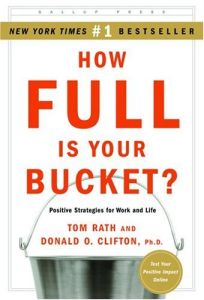Join getAbstract to access the summary!

Join getAbstract to access the summary!
Tom Rath and Donald O. Clifton
How Full Is Your Bucket?
Positive Strategies for Work and Life
Gallup Press, 2004
What's inside?
Every interaction either empties or fills your bucket of well-being. So think positive and pour it on.
Recommendation
Going through life with a short, handy, happy philosophy – particularly one as affirming as the concept in this book – is very nice. However, a fine line separates simple from simplistic. Although some readers will enjoy the breezy easiness of this approach, others might find it to be just a first step toward becoming more upbeat. Donald O. Clifton, a pioneer in positive psychology, and his co-author and grandson, Tom Rath, developed the “bucket” and “dipper” theories of happy emotions, based on Clifton’s research. The bucket is a metaphor for your sense of well-being. Every interaction fills your bucket or drains it. You also have a psychological dipper you use to add to or take away from other people’s sense of joy and security – their buckets. The choice, the authors explain, is yours. The book includes small drop-shaped cards for dropping a few friendly notes. It also provides five strategies that can increase your positive emotions and those of the other people in your life. If your bucket is perennially half-empty, getAbstract recommends dipping into this bestseller to see if it holds water for you.
Summary
About the Authors
The American Psychological Association recognized the late Donald O. Clifton, Ph.D., as the “Father of Strengths Psychology.” He chaired Gallup, Inc., and wrote Now, Discover Your Strengths. His grandson, Tom Rath, worked with him and now focuses on professional development programs.



















Comment on this summary